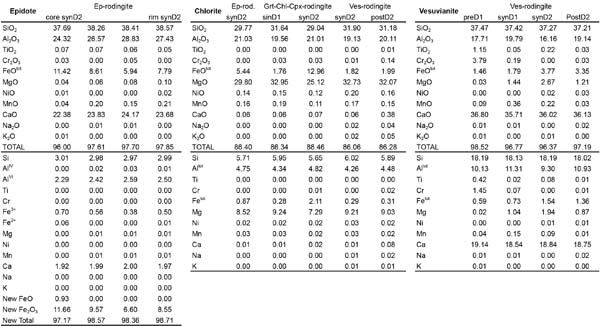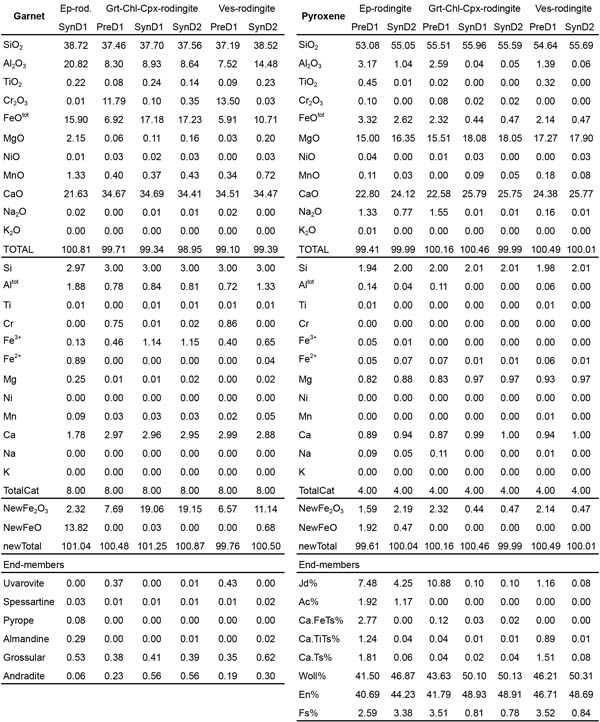Mineral chemistry
Mineral composition was measured with a Jeol, JXA-8200 electron microprobe (WDS, accelerating voltage of 15 kV, beam current of 15 nA) operating at the Department of Earth Sciences of Milano University. Natural silicates have been used as standards and the results were processed for matrix effects with a conventional ZAF procedure. Proportional formulae (see Tables 1 and 2) have been calculated on the basis of the following number of oxygen atoms: 6 for clinopyroxene, 12 for garnet, 12.5 for epidote, 28 for chlorite, and 76 for vesuvianite. Fe3+ was recalculated for garnet, epidote, and clinopyroxene on the basis of charge balance considerations.
Epidote
From core to rim, epidote marking S2 foliation shows an early decrease (0.70 - 0.35 atoms per formula unit - a.p.f.u.) followed by an increase (0.35 - 0.55 a.p.f.u.) in Fe3+ associated with a corresponding Al variation from 2.30 to 2.60 and from 2.65 to 2.40 (a.p.f.u.), respectively (Fig. 12a). Mn is ≤ 0.02 a.p.f.u. and Ca ranges between 1.92 and 2.00 a.p.f.u. (Table 1). EpidoteII in syn-D2 strain shadows is the richest in Al.
Figure 12. Compositional variation of epidote and clinopyroxene.

a) Compositional variations in Fe3+ vs. AlVI from core to rim (grey arrow) of the epidoteII. From b) to d) composition of different generations of clinopyroxene in the three rodingite types: Ca vs. Fe2++Mg (b), Mg vs. Fe2+ (c), and Mg vs. AlVI+Fe3+(d) binary diagrams. The grey arrow indicates the chemical evolution from pre-Alpine to Alpine grains.

Table 1. Selected analyses of epidote, chlorite, and vesuvianite.
Compositions of different generations of epidote, chlorite, and vesuvianite in the three rodingite types. Mineral formulae are calculated on the basis of 12.5, 28, and 76 oxygen atoms for epidote, chlorite, and vesuvianite respectively.
Clinopyroxene
Clinopyroxene is mainly a diopside with the core of pre-D1 clinopyroxene porphyroclasts richer in augitic component (Morimoto, 1988). Pre-D1 porphyroclasts have rims with a composition re-equilibrated with those of the rock matrix clinopyroxene. Pre-D1 clinopyroxene porphyroclasts from vesuvianite-bearing rodingites have the lowest augitic content (Ca = 0.94-1.00 a.p.f.u.) whereas those from epidote-bearing rodingites have the lowest Ca content (0.87-0.92 a.p.f.u.). Clinopyroxene in pre-D2 veins reach the highest Fe2+ content (in vesuvianite-bearing rodingite Fe2+ = 0.01 - 0.20; in garnet-chlorite-clinopyroxene-bearing rodingite Fe2+ = 0.07 - 0.17 a.p.f.u.) that decreases towards the clinopyroxene rim. In vesuvianite-bearing rodingites the composition of the pre-D2 clinopyroxene rim is similar to that of the syn-D2 clinopyroxene (Fe2+ = 0.01-0.06 a.p.f.u.). ClinopyroxeneII and clinopyroxeneI in garnet-chlorite-clinopyroxene-bearing rodingites have similar composition; Fe2+ ranges between 0.01 and 0.02 a.p.f.u.. ClinopyroxeneII from epidote-bearing rodingites, has higher Fe2+ (0.02 and 0.07 a.p.f.u.) and lower and variable Ca (0.87 to 0.96 a.p.f.u.) content with respect to that one from the other types of rodingites, also due to complex zoning.
ClinopyroxeneI and II composition overlaps that of the clinopyroxeneI and II filling the fractures intersecting pre-D1 clinopyroxene porphyroclasts (Fe2+ = 0.02 - 0.03 a.p.f.u.) supporting microstructural evidence that these fractures formed during D1 and D2 stages (Figs. 12b-d and Table 2).

Table 2. Selected analyses of garnet and clinopyroxene.
Compositions of different generations of garnet and clinopyroxene in the three rodingite types. Garnet end members are normalised to 1; sum of Al-schorlomite and morimotoite ≤ 0.02 (Locock, 2008). Clinopyroxene end members (Jd = jadeite; Ac = acmite; Ca.FeTs = Ca Fe-tschermakite; Ca.TiTs = Ca Ti-tschermakite; Ca.Ts = Ca-tschermakite; Woll = wollastonite; En = enstatite; Fs = ferrosilite) are expressed in per cent (Morimoto, 1988). Mineral formulae are calculated on the basis of 12 and 6 oxygen atoms for garnet and clinopyroxene respectively.
Garnet
In all rodingite types garnet mainly consists of andradite and grossular (Fig. 13 and Table 2), according to Locock (2008).
In the pre-D1 garnet porphyroclasts of garnet-chlorite-clinopyroxene-bearing rodingite, uvarovite (37 - 45%), grossular (22 - 38%), and andradite (23 - 35%) are lower than in those from vesuvianite-bearing rodingite (uvarovite is up to 65%, grossular up to 68%, and andradite up to 37%). In vesuvianite-bearing rodingite pre-D1 garnet has a composition grading to that of garnetII toward the rims (increasing in grossular and andradite and decreasing in uvarovite).
Figure 13. Composition of different generations of garnet

Composition of different generations of garnet in the three rodingite types is shown in almandine (Alm) + pyrope (Prp) + spessartine (Sps) vs. grossular (Grs) vs. andradite (Adr), grossular (Grs) vs. uvarovite (Uv) vs. andradite (Adr), and Ca vs. Fe2++Mn vs. Mg ternary diagrams. The grey arrow indicates the chemical evolution from pre-Alpine to Alpine generations of garnet.
Garnet in pre-D2 veins has almandine (i.e. almandine - 5-16%, spessartine - 1-3%, pyrope - 0-5%, grossular - 59-87%, andradite - 0-21%) higher than all other garnet generations, with the exception of garnetI in epidote-bearing rodingite, where almandine is even higher (28-29%).
In garnet-chlorite-clinopyroxene-bearing rodingites garnetI shows higher andradite content (65 to 56% from core to rim) than garnetII (andradite = 54-57%). Uvarovite is between 1 and 3% in garnetII and < 1% in garnetI. Garnet filling the clinopyroxene porphyroclast fractures shows lower content in andradite (47-50%) and higher in uvarovite (up to 5%) than garnetI and II; in garnet along clinopyroxene porphyroclast cleavages, andradite (40-45%) is even lower, whereas uvarovite (6-8%) is higher.
In vesuvianite-bearing rodingites garnet grown at the rims, on cleavages, or in fractures of clinopyroxene porphyroclasts shows similar compositional ranges (andradite = 31 to 62%, andradite = 37 to 54% and andradite = 23 to 59% respectively) in which andradite increases toward the rim. In addition, garnet along the clinopyroxene cleavages also shows complex zoning patterns. GarnetII has heterogeneous composition with andradite ranging between 7 and 66%, but clustering around 20 and 35%. Lower andradite contents (7-22%) occur where microstructures suggest a late garnet growth, whereas the highest contents (66%) are from rocks with the lowest modal amount of garnet and the highest of clinopyroxene.
H2O content in garnet, which is common in rodingites, was not measured. Hydrogrossular described in the literature generally contains more that 5% of H2O, and garnet from rodingites may reach about the 12% of H2O (e.g. Rossman & Aines, 1991). Before Fe2O3 recalculation, we estimated contents in H2O < 2% in our samples. In particular the most hydrated garnet are grown at the expenses of clinopyroxene porphyroclasts, especially in vesuvianite-bearing rodingites.
Chlorite
Chlorite (Table 1) is clinochlore with the sole exception of the chlorite in the pre-D2 veins in garnet-chlorite-clinopyroxene-bearing rodingites that is pycnochlorite (Hey, 1954). In vesuvianite- and epidote-bearing rodingites, chlorite shows lower Fe content with respect to that in garnet-chlorite-clinopyroxene-bearing rodingites. Si varies between 5.63 and 6.11 a.p.f.u., Mg between 6.63 and 9.39 a.p.f.u., and Fe between 0.25 and 2.68 a.p.f.u..
Vesuvianite
In vesuvianiteI Fetot is between 0.69 - 1.04 a.p.f.u. and Altot between 9.87 and 11.31 a.p.f.u. (Fig. 14a). In vesuvianiteII Fetot increases (1.11 - 1.54 a.p.f.u.) and Altot decreases (9.69 - 9.25 a.p.f.u.) toward the rim (Fig. 14d). Fetot in vesuvianite growing along fractures in clinopyroxene porphyroclasts is 1.48 - 1.70 a.p.f.u. and Altot is 9.04 - 9.15 a.p.f.u. (Figs. 14a-c). Vesuvianite growing along clinopyroxene porphyroclast cleavages shows Altot contents of 7.81 - 8.93 a.p.f.u. and Fetot contents of 1.37 - 1.68 a.p.f.u.. Post-D2 vesuvianite reaches the highest Altot (9.47 - 11.60 a.p.f.u.) and the lowest Fetot (0.52 - 1.55 a.p.f.u.) quantities (Fig. 14a).
Pre-D1 vesuvianite has a very distinct composition characterised by higher amount in Ca (> 19 a.p.f.u.), Cr (1.45 - 1.90 a.p.f.u.), and Ti (0.42 - 0.50 a.p.f.u.) and much lower in Mg (0.02 - 0.03 a.p.f.u.) with respect to the later generations of vesuvianite, which have Ca lower than 19, Cr up to 0.14, Ti up to 0.25 and Mg varying between 0.87 and 2.04 a.p.f.u. (Figs. 14b-c). Only vesuvianite that grew on cleavages of pre-D1 clinopyroxene porphyroclasts has very high Ti content (1.00 - 1.50 a.p.f.u.) provided by depletion in Ti of the clinopyroxene during vesuvianite growth that may occur at HP/UHP conditions, as accounted by their Fetot, Altot, and Mg contents, close to those of syn-D2 vesuvianite (Figs. 14a-c). In addition, also vesuvianite filling fractures in clinopyroxene porphyroclasts shows higher Ti amount than the other syn-D2 crystals (Fig. 14c).
Fe3+ in vesuvianite has been not recalculated because the total charge balance of the 13 Y sites does not satisfy the conditions reported by Gnos & Armbruster (2006). However, since the variation trends, from core to rim, of Fetot and Altot are opposite (Fig. 14d), we can infer that the Fetot increase is actually due to Fe3+.
Based on the modal proportion (see microstructural analysis) and the composition of single mineral phases in the three rodingite groups, the following bulk rock compositions in oxide weight per cent have been inferred:
SiO2 ≈ 43; CaO ≈ 20; Al2O3 ≈ 18; MgO ≈ 10; FeO ≈ 7 in epidote-bearing rodingites.
SiO2 ≈ 39; CaO ≈ 21; Al2O3 ≈ 14; MgO ≈ 14; FeO ≈ 10 in garnet-chlorite-clinopyroxene-bearing rodingites.
SiO2 ≈ 39; CaO ≈ 24; Al2O3 ≈ 16; MgO ≈ 14; FeO ≈ 5 in vesuvianite-bearing rodingites.
Typically the sum of Na2O, K2O, TiO2, Cr2O3, MnO is less than 2 weight per cent.
These compositions are comparable to those displayed by the rodingites of the Pfulwe region (Li et al., 2008).
Figure 14. Compositional variation in vesuvianite.

From a) to c) composition of different generations of vesuvianite is shown in Fetot vs. Altot (a), Mg vs. Altot (b), and Cr vs. Ti (c) binary diagrams. The grey arrow indicates the chemical evolution from pre-Alpine to late Alpine generations. d) Chemical zoning of a vesuvianite (I core and II rim) grain aligned with the S2 foliation. White line highlights the grain edge and white circles indicate the position of analysed points. Crossed polars.